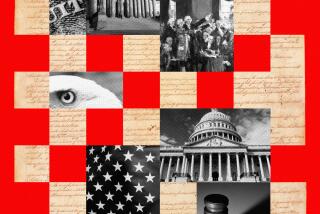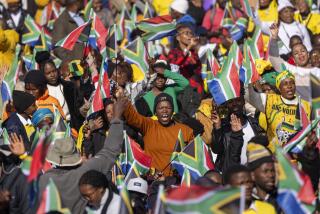Devil May Be in Details of South Africa Charter
- Share via
JOHANNESBURG, South Africa — The wide-ranging new constitution signed Thursday, designed to bury apartheid and usher in multiracial democracy, is a workable blueprint for government but has dangerous pitfalls for this strife-torn country, analysts say.
Several of the document’s most controversial provisions were passed with little apparent scrutiny or debate as bleary-eyed delegates rushed to finish the historic accord and begin the contest for the nation’s first all-race elections next April 27.
“It was like being in labor,” said Robert Schrire, a political analyst at the University of Cape Town. “The system is so pleased to give birth to anything at all that nobody quite cares at the time what it looks like.”
The 158-page document is more legalistic than inspirational. But Schrire says carefully worded clauses are more important than soaring rhetoric, given the deep distrust between the country’s privileged white minority and impoverished black majority.
“This is not a document that seals a nation, as the U.S. Constitution does,” he said. “It’s a peace treaty between warring parties.”
Still unclear is the role in the post-apartheid government of a key group of belligerents, the so-called Freedom Alliance. Politics has rarely made stranger bedfellows: The fractious alliance joins right-wing white parties opposed to black rule, two nominally independent black homelands created under apartheid and the militant Zulu-based Inkatha Freedom Party. One of the black leaders is being tried for murder; one of the white leaders has just been convicted of public violence in the deaths of three men.
The five parties in the alliance walked out of the constitutional talks in June over their joint demand for greater autonomy. The white extremists want a racially based Afrikaner homeland of their own, while the black leaders fear that their powers will be sharply curtailed. They have been making threats ever since.
Chief Mangosuthu Gatsha Buthelezi, a prominent black leader and head of the Inkatha Freedom Party, warned Thursday that a constitution negotiated without his party’s consent “will be reduced to the rubble of passing history.”
Black South Africans met white oppression with resistance, he said. “We will meet the present draft constitution, when it becomes law, with determined resistance.”
The saber rattling is even louder on the white right. Afrikaner Volksfront leader Constand Viljoen, former chief of South Africa’s armed forces, warned that the country is “on the brink of war” because of the new constitution.
The groups have meetings scheduled today with the African National Congress and the government, but previous attempts to find common ground and draw them back into the political process have been fruitless.
John Kane-Berman, executive director of the South African Institute of Race Relations, is worried. At least on paper, the alliance is one of the largest political groupings and includes heavily armed white and black factions that could destabilize an already fragile transition to democracy.
“The document, technically and legally, is workable,” Kane-Berman said. “But how broadly based is it? Its legitimacy must be based on popular support. And that’s a real question.”
Another land mine is South Africa’s new map. The constitution divides the country into nine new provinces, replacing the four current regions and abolishing 10 black homelands created under the apartheid policy of racial separation. Four of the homelands--Transkei, Ciskei, Venda and Bophuthatswana--are supposedly independent but are recognized only by Pretoria.
Bophuthatswana, in particular, does not want to change. Bop, as it is known, is broken into a series of non-contiguous zones, like ink splattered on a map. But it has a resource-rich economy and could well survive on its own.
“Bop has the capacity to hold out,” said John Dugard, former director of the Center for Applied Legal Studies. “The question is who’s going to enforce the new law? Will the new government send in troops? I doubt it.”
*
Another sensitive decision, made with surprisingly little discussion, will create a unified army made up of the South African Defense Forces, the black homeland armies and a ragtag array of political militias and guerrilla groups. Police forces will be created at the provincial and national levels.
Another decision offers restitution to blacks dispossessed of land by discriminatory laws passed since 1913. Depending how that is carried out, the land reform could pit rural white landholders against blacks.
The nation’s first bill of rights, incorporated in the constitution, expresses much of the hope that has grown in the nearly four years since President Frederik W. de Klerk released African National Congress leader Nelson Mandela from 27 years in prison, removed the ban on political parties with primarily black membership and began talks to end over three centuries of white rule.
But the rights bill also embodies much of the fear and enmity of recent years. Since many of the black delegates were imprisoned and tortured during white rule, perhaps it is not surprising that torture is specifically outlawed, and three full pages are devoted to limiting powers the government may assume in a state of emergency.
A Western diplomat who has followed the talks fears that the delegates may have gone too far in their attempts to prevent abuses.
“Freedom of speech (under the constitution) means you can’t use racist language, and freedom of the press means you can’t print it,” he said. “All these things were written by people who don’t understand freedoms.”
Still, he described the charter as “within the spectrum of democratic constitutions in the West.” It grants adults the right to vote, protects labor unions, creates an independent judiciary and offers proportional representation in a complex system of checks and balances.
Standard stuff elsewhere, perhaps, but those basic rights and freedoms are nothing less than revolutionary in a land that was an authoritarian, one-party police state only four years ago.
More to Read
Sign up for Essential California
The most important California stories and recommendations in your inbox every morning.
You may occasionally receive promotional content from the Los Angeles Times.














